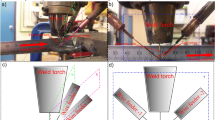Abstract
Gas metal arc welding (GMAW) with direct current electrode negative (DCEN) can offer some advantages over direct current electrode positive (DCEP) welding, such as a higher electrode melting rate and lower heat input imposed onto the workpiece. Despite these advantages, DCEN is not commonly used in field applications due to instabilities caused by arc climb and the volatile repelled metal transfer mode across the arc. This work reports a comparison between DCEP and DCEN in natural spray transfer mode using a welding power source operating in constant voltage (CV). It aims to assess the feasibility of DCEN in cold wire gas metal arc welding (CW-GMAW) comparing the results obtained in DCEN with previous results obtained in DCEP for the same welding parameters. During experiments, the current and voltage were acquired with synchronized high-speed video to study the arc dynamics. Bead-on-plate welds were deposited onto AISI 1020 steel flat bars. Three cross sections for each bead were cut and metallographically examined to compare bead geometry. Results suggest that the cold wire feeding can suppress arc climb in DCEN welding, consequently improving the arc stability and bead finish. Moreover, the DCEN welds suggest that the heat transferred to the weld pool is fundamental to accommodate high feed rates of cold wire. Lastly, the cross section results show that penetration, dilution, and HAZ area are lower in DCEN than in DCEP mode.

















Similar content being viewed by others
References
Norrish J (1974) High deposition MIG-welding with electrode negative polarity. In: 3rd Intl. Conf. on Advances in Welding Processes. The welding Institute, Cambridge, UK., pp 121–128
Souza D, de Resende AA, Scotti A (2010) A qualitative model to explain the polarity influence on the fusion rate in the MIG/MAG process. Weld Int 24:934–941. https://doi.org/10.1080/09507110903569032
Li P, Hurtig K, Högström M, Svensson LE, Scotti A (2018) A contribution to the study of negative polarity in GMA welding. Int J Adv Manuf Technol 95:2543–2553. https://doi.org/10.1007/s00170-017-1349-z
Cho J, Lee J-J, Bae S-H (2015) Heat input analysis of variable polarity arc welding of aluminum. Int J Adv Manuf Technol 81:1273–1280. https://doi.org/10.1007/s00170-015-7292-y
Kim K, Chung H (2017) Wire melting rate of alternating current gas metal arc welding. Int J Adv Manuf Technol 90:1253–1263. https://doi.org/10.1007/s00170-016-9384-8
Cabral TS, Braga EM, Mendonça EAM, Scott A (2015) Influence of procedures and transfer modes in MAG welding in the reduction of deformations on marine structure panels. Weld Int 29:928–936. https://doi.org/10.1080/09507116.2014.932993
Costa ES, Assunção PDC, Dos Santos EBF, Feio LG, Bittencourt MSQ, Braga EM (2017) Residual stresses in cold-wire gas metal arc welding. Sci Technol Weld Join 22:706–713. https://doi.org/10.1080/13621718.2017.1306014
Marques LFN, dos Santos EBF, Gerlich AP, Braga EM (2017) Fatigue life assessment of weld joints manufactured by GMAW and CW-GMAW processes. Sci Technol Weld Join 22:87–96. https://doi.org/10.1080/13621718.2016.1194735
ASTM (2009) Standard specification for general requirements for steel bars, carbon and alloy, hot-wrought. Changes i:1–16. https://doi.org/10.1520/A0029
AWS (2005) AWS A5.28/A5.28M:2005 - Specification for low-alloy steel electrodes and rods for gas shielded arc welding, p 43
LEM (1997) Current transducer LF 505-S / SP15, pp 1–2
LEM (2017) Voltage transducer LV 100-100 Data Sheet. In: 3
do NAS, Batista M de A, do NVC, Scotti A (2007) Assessment of electrical power calculation methods in arc welding and the consequences on the joint geometric, thermal and metallurgical predictions. Soldag Inspeção 12:97–106
Kodama S, Ikuno Y, Ichiyama Y, Baba N (2007) Process modeling of short-circuiting GMA welding and its application to arc sensor control. Nippon Steel Tech Rep 95:71–75
Hajossy R, Morva I (1994) Cathode and anode falls of arcs with fusible electrodes. J Phys D Appl Phys 27:2095–2101. https://doi.org/10.1088/0022-3727/27/10/016
Ribeiro RA, dos Santos EBF, Assunção PDC, Braga EM, Gerlich AP (2018) Cold wire gas metal arc welding: droplet transfer and geometry. Weld J Res Suppl:21
Cary HB (1989) Modern welding technology, 2nd edn. Prentice-Hall, Englewood Cliffs, New Jersey
Jenney CL, O’Brien A (2004) Welding handbook, 9th edn. AWS, Miami, FL
Murray PE, Scotti A (1999) Depth of penetration in gas metal arc welding. Sci Technol Weld Join 4:112–117. https://doi.org/10.1179/136217199101537644
Fuerschbach PW (1994) A Dimensionless parameter model for arc welding processes. In: International Conference on Trends in Welding Research, Gatlinburg, TN, USA
Mendez PF, Lu Y, Wang Y (2018) Scaling analysis of a moving point heat source in steady-state on a semi-infinite solid. J Heat Transfer 140:081301. https://doi.org/10.1115/1.4039353
Scotti A, Rodrigues CEAL (2009) Determination of momentum as a mean of quantifying the mechanical energy delivered by droplets during MIG/MAG welding. Eur Phys J Appl Phys 45:11201. https://doi.org/10.1051/epjap:2008196
DuPont JN, Marder AR (1996) Dilution in single pass arc welds. Metall Mater Trans B 27:481–489. https://doi.org/10.1007/BF02914913
Author information
Authors and Affiliations
Corresponding author
Additional information
Publisher’s note
Springer Nature remains neutral with regard to jurisdictional claims in published maps and institutional affiliations.
Rights and permissions
About this article
Cite this article
Assunção, P.D.C., Ribeiro, R.A., Dos Santos, E.B.F. et al. Comparing CW-GMAW in direct current electrode positive (DCEP) and direct current electrode negative (DCEN). Int J Adv Manuf Technol 104, 2899–2910 (2019). https://doi.org/10.1007/s00170-019-04175-2
Received:
Accepted:
Published:
Issue Date:
DOI: https://doi.org/10.1007/s00170-019-04175-2



